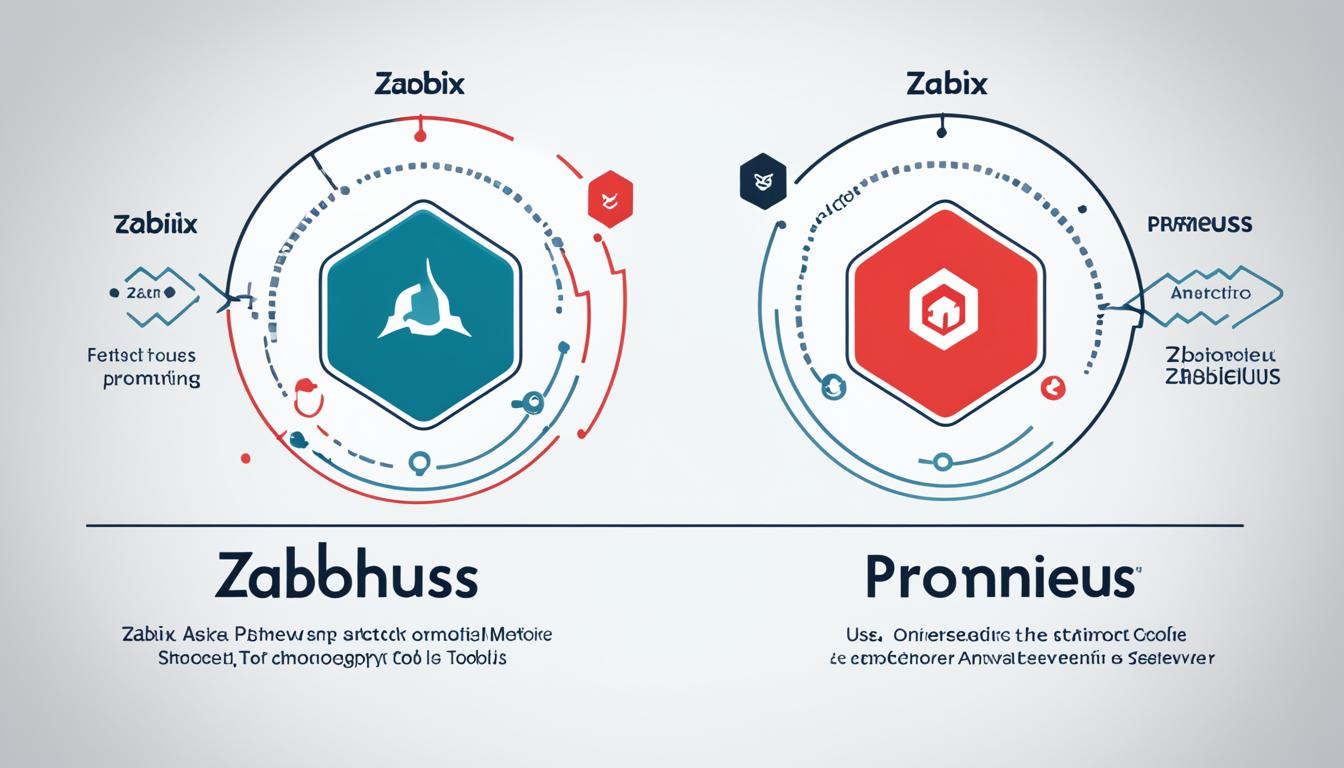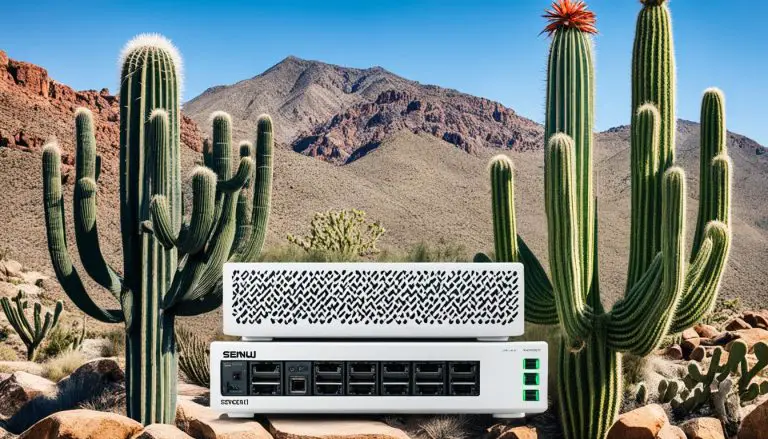Zabbix vs. Prometheus: An Expert’s Comparison Guide
Are you struggling to choose the best network monitoring tool for your system? Let me guide you through the comparison of two popular open-source monitoring solutions: Zabbix and Prometheus. With their alerting and visualization features, performance metrics analysis, and open-source nature, they both offer compelling options. But which one is the right fit for your needs?
In this expert’s comparison guide, we will dive deep into the pros and cons of Zabbix and Prometheus and explore their key differences. We will analyze their use cases, data processing capabilities, machine learning support, query languages, deployment models, integration abilities, security features, scalability, and more. By the end, you’ll have a clear understanding of which monitoring tool is the best choice for you.
Key Takeaways:
- Zabbix and Prometheus are popular open-source monitoring tools for managing IT infrastructure.
- Zabbix excels in IT infrastructure monitoring, performance troubleshooting, security monitoring, and business process monitoring.
- Prometheus is preferred for monitoring and alerting for applications, system performance analysis, and cloud infrastructure monitoring.
- Prometheus is designed for processing time-series data, while Zabbix handles structured and unstructured data.
- Prometheus integrates well with Grafana, Kubernetes, and other tools, while Zabbix offers extensive integration capabilities as well.
Use Cases
Zabbix and Prometheus have different use cases for monitoring and managing IT infrastructure.
Prometheus is commonly used for monitoring and alerting for applications, servers, and network devices. It excels at analyzing system and application performance over time, enabling organizations to identify trends, optimize resources, and troubleshoot issues in production environments. With its robust capabilities, Prometheus supports debugging and troubleshooting, allowing teams to quickly identify and resolve performance bottlenecks and application errors. It also aids in capacity planning and resource optimization by providing insights into resource utilization and predicting future needs. Additionally, Prometheus is well-suited for cloud infrastructure monitoring and management, providing visibility into dynamic and scalable environments.
On the other hand, Zabbix is primarily used for IT infrastructure monitoring and provides a comprehensive solution for monitoring network devices, servers, applications, and databases. It’s particularly useful for organizations that require monitoring and managing complex IT infrastructures. Zabbix offers powerful performance monitoring and troubleshooting capabilities, allowing teams to proactively detect and resolve issues before they impact system availability and performance. The platform also excels at security monitoring and threat detection, leveraging its robust monitoring capabilities to identify and mitigate potential security risks. Additionally, Zabbix supports business process monitoring and reporting, enabling organizations to monitor critical business workflows and generate performance reports for decision-making purposes.
Both Zabbix and Prometheus offer a wide range of use cases encompassing system and application performance, debugging and troubleshooting, capacity planning, resource optimization, cloud infrastructure monitoring, IT infrastructure monitoring, security monitoring, and business process monitoring. The choice between the two tools depends on specific requirements and the nature of the infrastructure being monitored.
Data Processing
When it comes to data processing, Zabbix and Prometheus take different approaches. Prometheus specializes in processing time-series data, which consists of data points indexed by time. This allows Prometheus to handle large volumes of data effortlessly and analyze it over extended periods.
Zabbix, on the other hand, has the capability to process both structured and unstructured data, making it suitable for IT infrastructure monitoring and analysis. It offers data ingestion capabilities, allowing it to collect data from various protocols like SNMP, JMX, and IPMI. This makes Zabbix versatile in gathering information from different sources.
Furthermore, both tools have distinct data transformation capabilities. Prometheus utilizes PromQL, a powerful query language that enables users to transform, aggregate, and filter time-series data. With PromQL, users can perform complex analyses and extract valuable insights from their data.
Zabbix, on the other hand, allows data transformation and normalization through pre-processing, filtering, and data conversion techniques. This flexibility enables users to manipulate the data to suit their specific requirements and improve the accuracy of their monitoring and analysis.
Overall, both Prometheus and Zabbix offer robust data processing capabilities, each with its own strengths and advantages. The choice between the two will depend on the type of data you are working with and the specific requirements of your monitoring and management needs.
Machine Learning Support
While both Zabbix and Prometheus offer valuable features for monitoring and managing IT infrastructure, their machine learning support capabilities differ.
Prometheus has some built-in machine learning capabilities, although they are limited in scope. However, it excels in its ability to integrate with third-party tools, allowing users to leverage advanced analytics and anomaly detection solutions.
Zabbix, on the other hand, does not have built-in machine learning support. However, it provides extensive support for integration with third-party machine learning tools. This enables organizations with specific advanced ML requirements to utilize their preferred machine learning solutions alongside Zabbix.
To further enhance monitoring and analysis, organizations can integrate Zabbix or Prometheus with machine learning tools like TensorFlow or scikit-learn, enabling them to leverage the power of machine learning algorithms for optimization, predictive analytics, and automated anomaly detection.
By integrating machine learning capabilities into their monitoring setup, organizations can gain deeper insights, improve accuracy, and enhance proactive decision-making for their IT infrastructure.
Query Language
In the realm of monitoring tools, query languages play a crucial role in data retrieval and analysis. Both Prometheus and Zabbix make use of distinct query languages tailored to their respective functionalities.
Prometheus employs PromQL, an expressive query language specifically designed for analyzing time-series data. With PromQL, users gain access to a rich set of functions that enable advanced analysis and complex operations on time-series data. This query language empowers users to make informed decisions based on extensive data analysis.
Zabbix, on the other hand, relies on its own query language called Zabbix Query Language (ZQL). This language equips users with the capabilities to retrieve and analyze data from the monitored devices within the infrastructure. ZQL allows users to unlock valuable insights by querying the data collected by Zabbix.
Both PromQL and ZQL have unique syntaxes and functions that cater to specific data analysis needs. The availability of a well-designed query language ensures a seamless data analysis experience for users of Prometheus and Zabbix.
Deployment Model
When considering the deployment model for your monitoring solution, both Zabbix and Prometheus offer flexible options to suit your organization’s infrastructure requirements. Whether you prefer on-premises or cloud-based deployment, both tools have got you covered.
Prometheus can be deployed either on-premises or in the cloud, providing you with the freedom to choose the deployment model that works best for your organization. It also supports various deployment setups such as standalone, clustered, and federated setups, allowing you to scale and distribute your monitoring infrastructure as needed.
Zabbix, similar to Prometheus, offers the flexibility of on-premises and cloud deployment, ensuring that you can deploy it in an environment that suits your preferences and requirements. This deployment model allows you to monitor your infrastructure effectively, regardless of its location.
Whether you choose Zabbix or Prometheus, you can confidently select a deployment model that aligns with your organization’s needs, optimizing your monitoring capabilities for improved performance and efficiency.
- On-premises deployment: Installing and running the monitoring tools on your own servers and infrastructure.
- Cloud deployment: Deploying the monitoring tools in a cloud environment, such as Amazon Web Services (AWS) or Microsoft Azure.
- Standalone setup: Setting up a single instance of the monitoring tool for monitoring a specific system or network.
- Clustered setup: Deploying multiple instances of the monitoring tool for increased scalability and redundancy.
- Federated setup: Connecting and synchronizing multiple instances of the monitoring tool across different locations or organizations.
By offering diverse deployment models, both Zabbix and Prometheus ensure that organizations can choose the most suitable setup to meet their specific monitoring needs and infrastructure requirements.
Integration with Other Services
Both Zabbix and Prometheus have extensive integration capabilities with other tools and services in the monitoring and observability space. These integration capabilities allow users to combine the functionalities of these tools and services for a comprehensive monitoring solution.
Prometheus integrates well with Grafana, a popular data visualization tool that provides rich and interactive dashboards for data analysis and visualization. By integrating Prometheus with Grafana, users can create visually appealing and customizable dashboards to monitor and analyze their system’s performance metrics.
Prometheus also integrates with Alertmanager for managing alerts and notifications. With this integration, users can configure alert rules in Prometheus and define how they want to be notified when certain conditions are met. Alertmanager allows users to route alerts to different channels such as email, Slack, PagerDuty, or other communication platforms, ensuring that critical issues are promptly addressed.
Additionally, Prometheus has seamless integration with Kubernetes, a popular container orchestration platform. By integrating Prometheus with Kubernetes, users can monitor the performance and health of their containerized applications and infrastructure, gaining insights into resource utilization, scaling, and load balancing.
On the other hand, Zabbix offers integration with various tools and services, including Grafana, Prometheus, Elasticsearch, and AWS. The integration with Grafana allows users to leverage Grafana’s advanced visualization capabilities and create visually compelling dashboards to monitor and analyze their infrastructure.
“Integrating Prometheus with Grafana empowers users to create visually stunning dashboards, enabling them to gain deeper insights into their system’s performance and make informed decisions.”
Zabbix’s integration with Prometheus allows users to leverage Prometheus for time-series data collection and analysis. By integrating Zabbix with Prometheus, users can take advantage of Prometheus’ powerful data processing capabilities and seamlessly collect and analyze metrics data from various systems and applications.
Zabbix also integrates with Elasticsearch, a widely-used search and analytics engine. This integration enables users to store and analyze monitoring data in Elasticsearch, making it easier to perform advanced searches, aggregations, and visualizations on the monitored data.
Furthermore, Zabbix provides integration with AWS, allowing users to monitor and manage their AWS resources directly from the Zabbix interface. This integration enables users to gain insights into their AWS infrastructure’s performance and health, configure AWS-specific monitoring templates, and receive notifications on critical events.
These integration capabilities of both Zabbix and Prometheus make them flexible and versatile monitoring solutions, capable of integrating with a wide range of tools and services to provide a comprehensive monitoring and observability platform.
Security
Ensuring the privacy and security of data is a crucial aspect of any monitoring tool. Both Zabbix and Prometheus offer robust security features to protect your valuable information.
Prometheus provides support for Transport Layer Security (TLS) encryption, which enables secure communication between components. This encryption protocol adds an extra layer of protection to prevent unauthorized access or data tampering. Additionally, Prometheus offers authentication and authorization mechanisms to restrict access to sensitive data and ensure that only authorized users can interact with the system.
Zabbix also prioritizes data security by offering secure communication and authentication methods. This ensures that the data transmitted between different components of the monitoring system remains confidential and cannot be intercepted by unauthorized users. By implementing strong authentication mechanisms, such as multi-factor authentication or access control lists, Zabbix enhances the overall security posture of your monitored environment.

By deploying either Zabbix or Prometheus, you can have peace of mind knowing that your data is safeguarded through encryption, authentication, authorization, and secure communication.
Conclusion
In conclusion, both Zabbix and Prometheus are powerful open-source monitoring tools with their unique features and strengths. The comparison between Zabbix and Prometheus highlights the importance of considering various factors when choosing the best monitoring solution for your system’s performance and alerting needs.
Factors to consider include use cases, data processing capabilities, machine learning support, query languages, deployment models, integration abilities, security features, pricing models, scalability, performance, reliability, monitoring and management capabilities, and developer tools. Evaluating these factors will help determine the best fit for your organization’s specific use case, infrastructure requirements, and preferences.
Ultimately, the decision between Zabbix and Prometheus comes down to your organization’s specific needs and priorities. Both have their own strengths, and it’s essential to weigh the pros and cons of each tool to make an informed choice. By considering all aspects of the comparison, you can confidently select the best monitoring solution that will contribute to your organization’s success.
FAQ
What are the use cases for Zabbix and Prometheus?
How do Zabbix and Prometheus handle data processing?
Do Zabbix and Prometheus have machine learning support?
What query languages do Zabbix and Prometheus use?
What deployment models are available for Zabbix and Prometheus?
Which other services can Zabbix and Prometheus integrate with?
What security features do Zabbix and Prometheus offer?
- About the Author
- Latest Posts
Mark is a senior content editor at Text-Center.com and has more than 20 years of experience with linux and windows operating systems. He also writes for Biteno.com






